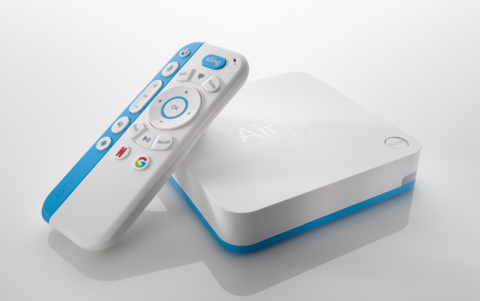As the pay TV company most vocally fed up with fast-rising broadcast retransmission licensing fees, Dish Network has developed a very useful tool for cord cutters to receive over-the-air channels on practically any device throughout their home.

But the technological concept is going to be hard to sell to consumers, particularly with a confounding Dish branding strategy that favors sticking the same name on multiple products. (Remember three and a half years ago when Sling TV came out, and many of us were still using Sling Boxes?)
In May, a year after releasing its AirTV Player OTT device (pictured below), Dish introduced a $120 device simply called AirTV. The former, which sells for $130, is essentially an Android TV-based streaming player. Packaged with the AirTV adapter—which connects the OTT device to an over-the-air antenna—users can integrate all local broadcast channels into the Sling TV virtual pay TV service. Netflix is native to the remote, and other apps and transactional services can be found in Google Play.
The new AirTV is actually an 802.22n, 2x2 dual-band Wi-Fi device, with two ATCS 8VSB tuners, designed to connect to an over-the-air antenna and make broadcast channels available to pretty much any device for which there is an AirTV app.
It’s not an OTT player. It’s a Wi-Fi device for whole-home streaming of broadcast channels. And it works pretty well.
I connected my review unit to a new amplified Mohu Leaf 50 antenna. Unlike the AirTV Player and Adapter, you aren’t tethered to your living room—you can place the device anywhere in your home that has access to a power outlet and which has decent Wi-Fi reception. This is useful ability that lets the user find the best spot in their home for OTA reception.

Having hooked up and configured numerous OTT players and antennas previously, I was able to get the through the entire setup process in about 10 minutes—that included downloading AirTV apps for my iPhone and Roku player, connecting the device to my Wi-Fi network, and letting the box find all the available broadcast channels.
Being able to strategically place the antenna is huge—I was able to receive, for the first time since I ditched DirecTV satellite three years ago, KCBS-TV and its associated subnets.
Those who hate the Sling TV user interface will not like the apps. As a Sling user for nearly three years, I’m pretty used to it and found the experience acceptable. I liked a menu bar that let me know the level of station reception quality (ranges from “poor” to “good”).
As far as a review goes, I can sum all that up by saying that AirTV is an unsexy, uncomplicated device that does its job well. For $180 worth of hardware ($60 for the Mohu Leaf), I have access to all my locals, no matter what vMVPD package I subscribe to.
For Sling TV users, the investment makes a lot of sense. Dish Network and Sling are currently battling Univision over program licensing contracts, and the channel and most of its associated networks are currently blacked out on Dish satellite and Sling.
For its part, Sling announced earlier this week that its Broadcast Extra $5-a-month add-on, which not only includes the Spanish-language Univision but ABC as well, is no longer available. And Sling TV, of course, doesn’t offer CBS. It does deliver national feeds of Fox and NBC through the Sling “Blue” platform.
Estimating that about half of vMVPD homes have an over-the-air antenna, Dish sees an opportunity. In a presentation delivered at Fierce’s Pay TV Show in May, Warren Schlichting, the sharp-witted top program negotiator for both Dish and Sling, estimated that consumers can save around $12 a month by not tacking on broadcast channels to their pay TV bill.
Given the rate of increase for broadcast retrans, “that could be $15 by next year,” he said.
So, Dish does have a pretty interesting proposition to sell here—a device that takes care of the local channels issue and pays for itself in about eight months.
Can Dish effectively use AirTV to proliferate Sling TV, which is its essential purpose?
Well, based on the sales performance of the AirTV Player—which also lets users mix broadcast channels with Sling TV’s $25-a-month basic mix of cable networks, albeit on an individual TV set—it’s tough to say that the AirTV Wi-Fi device will spread like wildfire.
The essential value of the device would seem to be as a bundled offer with Sling TV, allowing Dish to provide streaming access to all locals, plus ESPN, TNT, AMC, CNN and all of the rest of the essentials, for $25 a month. Dish has been the least aggressive in signing retrans contracts with local stations—it doesn’t even have a master deal with CBS—so this would solve a key problem and keep Sling TV’s price point among the lowest in the virtual pay TV business.
Relative to other vMVPDs, the satellite operator hasn’t been that aggressive in promotions tying the AirTV Player to monthly virtual service subscription. While other virtual pay TV operators have offered such enticements as free Roku and Apple TV devices to goose subscriptions, Dish has merely put out discount promotions. For example, purchasers of the AirTV Player and Adapter can get a $50 credit on Sling TV; and Sling TV subscribers can get the AirTV Player and Adapter at $50 (an $80 discount).
In fact, Dish seems to believe in its own player so little, that it also alternatively offers prospective Sling TV subscribers a free Roku Express ($30 value), or $50 off a Roku Ultra. Dish, which also gives away free antennas with Sling subscriptions, has not yet begun bundling the AirTV Wi-Fi device with Sling.
After a year in the market, Dish hasn’t revealed sales figures for its AirTV Player and Adapter. Reporting around 2.3 million subscribers for Sling TV at the end of the first quarter, it still has the most virtual pay TV subscribers. But Sling’s growth has slowed relative to DirecTV Now, which gathered 1.5 million users in a span of just 16 months.
When Dish does finally start integrating AirTV into Sling TV sales, I’m curious to see how it will differentiate the device from the almost-identically monikered AirTV Player … and also how it will explain the key difference in terms of what the whole-home Wi-Fi device does relative to the player.
Again, it’s an intriguing proposition, but a heck of a marketing challenge.